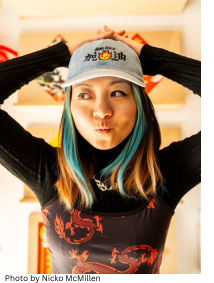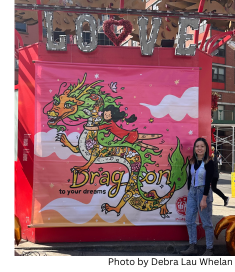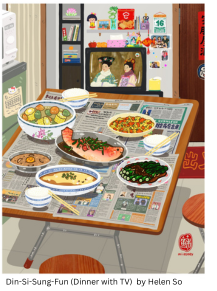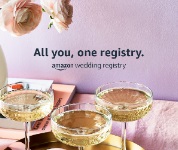
New York’s Chinatown just gained a new attraction: local artist Helen So recently unveiled her latest creation, Drag on to your dreams,” a colorful cartoon-like depiction of a young girl riding on the back of a dragon flying high above the clouds. So says her theme was a play on the word “dragon,” this year’s Lunar New Year animal, because sometimes “you have to drag on to something--the support of your friends, family, and community--to keep your dreams alive.”
 So should know. The former art teacher and Hong Kong
native arrived in the Big Apple two and a half years ago, and has
since embedded herself in the Chinatown community, where she
volunteers, raises money for charities, and showcases her work at
popular fixtures such as Spongies Cafe, Artbean Coffee, and Yu and Me Books.
So should know. The former art teacher and Hong Kong
native arrived in the Big Apple two and a half years ago, and has
since embedded herself in the Chinatown community, where she
volunteers, raises money for charities, and showcases her work at
popular fixtures such as Spongies Cafe, Artbean Coffee, and Yu and Me Books.
Wellington Chen, executive director of the Chinatown Partnership, says he chose to highlight So’s work during Women’s History Month and the upcoming Asian Pacific American Heritage Month because there are so many “crouching tiger, hidden dragon” artists who need support as they “pursue their passions and soar.”
We spoke to So, 35, about her journey to New York, what drew her to Chinatown, and why she’s a bad art teacher. Visitors to the city can see her latest work featured at the information kiosk on the corner of Baxter and Canal Streets.
______________________________
 Your new banner in Chinatown is so uplifting and
positive. What was the inspiration behind it?
Your new banner in Chinatown is so uplifting and
positive. What was the inspiration behind it?
Because 2024 is the year of the Wood Dragon, I placed a lot of major elements onto the dragon. Instead of a scale pattern, I added flowers, leaves, and smiley faces because these are regular elements that appear in my artwork. They also symbolize growth and connecting with nature.
What message do you hope to deliver?
I create my artwork to show people there are little things in life to remind us of our value, worth, and place in this world. We should be the greatest dragons we can be. I'm in Chinatown a lot and always walk by the spot [where my art is displayed]. Art gives people in a community hope when they see it. I arrived in New York City during the peak of the Asian hate years. It does give me a different lens on what I work on and how I communicate with the local community.
How did you end up in New York?
My husband and I met in Hong Kong. He’s from the U.S., and because of his job, he had to come back to the states. We were pretty flexible about which city we could stay in, and New York is similar to Hong Kong, in the sense that it has lots of culture, so we thought it would be easier for the both of us to start a new chapter here.
Were you surprised by how quickly you formed a bond with the Chinatown community?
Before I came to New York, I didn't really see myself tying in with the Asian community. I thought, “OK, I'm from Hong Kong, so I’ll hang out with all these different cultures.” And I do. But I think the longer I stay here, the longer I have this longing to find that second home. At the beginning, I was like a tourist around Chinatown, but then I started to see familiarity. There were a lot of people speaking Cantonese, and even though it’s not the same [as being in Hong Kong], there was the same kind of feeling.
Spongies is a favorite Chinatown haunt. How did you connect with this family-owned business?
I wasn't even aware that there was a place called Spongies Cafe. I was printing some of my art in a local printing store, and the lady there who spoke Cantonese asked me if I had lunch yet and handed me a sponge cake. After that, I left the store and saw Spongies on my way home. I went in and introduced myself but didn’t buy anything because I was still holding a sponge cake in my hand. The rest is history. We became friends, and they just welcomed me like family.
How did you and other local artists start showing your work there?
I started to go more often and realized that they show artwork. I met their social media person, and told her I was an art teacher before I moved here and that opened up a conversation. I had my first show there in 2023, and then last May, I organized a group exhibition with a team of 18 artists for AAPI Heritage Month. I wanted to connect all of these wonderful artists that I came across in the past two and a half years to create a safe space for everybody to show their work.
You also show your work at Yu and Me Books, which I think is one of the first Asian-woman-owned bookstores.
My first encounter with Yu and Me was when one of my best friends told me about their open mic night. I was inspired by the whole night and read my little book about how I am a bad art teacher. I guess that left a big impression with the owner, Lucy Yu, and eventually she wanted to carry my stickers and prints in the bookstore. I also made a little sticker design of the storefront with a cat and it's so well-loved that it's become one of the most popular ones they sell.
Why are you a bad art teacher?
I was an art teacher in a private art studio in Hong Kong for a few years before I came to the states, and the experience inspired me to create a book. In Asia, rather than having kids enjoy the process of experimenting with materials, everybody is looking for results. And that can be a little limiting and controlling in terms of what kids actually create. I was having a little difficulty myself during the process, and I didn't enjoy it. The idea behind Bad Teacher was to remind people that art can be inside or outside of the classroom. There are little things in life that can inspire us, and they don't have to be in a frame. You don’t have to color within the lines all the time. What I have learned from my experience is once you ask kids to make a perfect circle, it’s very hard for them to un-learn that. And kids are so unforgiving that they get so frustrated with themselves. It was one of the hardest things to watch kids who were unsatisfied with what they created that they broke down and cried.
So what did you teach your students instead?
I taught them not to focus on the final product. So many art studios and teachers focus on that, but I tried to find the right balance for them and for myself. I know that I need to fulfill some kind of expectation as a teacher, but I tried to inspire them a little bit more.
You’ve said that the beauty of perfection and imperfection is what interests you the most. Can you please explain.
A few years ago, I was collecting seashells in Hong Kong and so many were broken, nothing like the perfect ones that you see online. I started to look inside of the seashell and there was a shift in my perspective: you can find beauty in brokenness.
Did you come from a family of artists?
No, I didn’t live with my dad, and my mom worked in hotels, restaurants, and in insurance, so I spent quite a few years with my grandma. I was the only kid at home until my brother came along 17 years later, so I had a lot of free time on my own. I read comics, and I watched cartoons, and I liked to draw them. My mom saw that I had an interest in drawing, so I started art classes when I was very young.
 Are you a classically trained artist?
Are you a classically trained artist?
I went to the Chinese University of Hong Kong, and I studied fine arts for three years and experimented with all different mediums.
Where did your interest in comic/doodling art start?
I worked at the Hong Kong Arts Centre curating shows and programs and I got to know Hong Kong comic artists and animators. I guess that’s how I slowly started to develop my doodling style. My markers and my digital work are more like doodling or comic-style. I don't do comics because they are complicated, but I would say my work is like a comic on one page. So you'll see a lot of different elements, like drawings with words, so I can try to connect with the audience on a personal level. With my doodling and detailed drawings, people can just read them for what they are and their topics are relatable.
What mediums are you most comfortable working with?
I work with a lot of mediums, but I'm most comfortable with markers and acrylics. I also like to use my iPad because it’s fast and easy to visualize what I have in mind. I do a lot of sticker design, and with the iPad it’s the fastest way and has clean outlines and vibrant colors. I love to explore all sorts of mediums so I don't have a limitation, so sometimes people get confused, and say, “Oh, this is your work as well?”
Describe your fan base.
I would say 60 percent of my audience is Asian Americans because I do have a lot of Cantonese elements in my artwork that they can relate to. But I also love nature, which is a universal language, and those elements attract the other 40 percent of all different kinds of people.
Where does your artist name “Miiasoey” come from?
Helen is the name that my mom gave me, and Miia is the name that I
picked for myself. One of my favorite movies growing up was The
Princess Diaries and Mia was the main character. I
added an extra “i” because I wanted to be even more special. So is
my surname, and one of my good friends when I was studying in the
U.K. has the surname Zuni, so I would call her Zuni and she would
call me Soey. So I put the names together.
Do you show your work mostly in the U.S. or around the world?
I had a few shows in Hong Kong, Malaysia, and the Philippines. But for the time being, I’m focused mainly on New York City. In the near future, I want to expand to other states and the West Coast. I recently launched my online store and so hopefully, I can reach out to a wider audience.
What are you working on now?
People tell me that my art reminds them of I Spy books. The next project I want to work on is about store cats. I have a book idea that involves cats from all over; an herbal tea store cat, bodega cats, cats in a bookstore, and a Chinese herbal medicine store. It’s not just about the cats but learning a little bit more about the store culture.
You’re a full time artist living in New York City. Sounds like you’re living the dream.
I always tell my friends in Hong Kong that I have produced more artwork in the past two and a half years than I have in my life. I am living the dream, but you also have to keep dreaming.
Edited for space and clarity.

